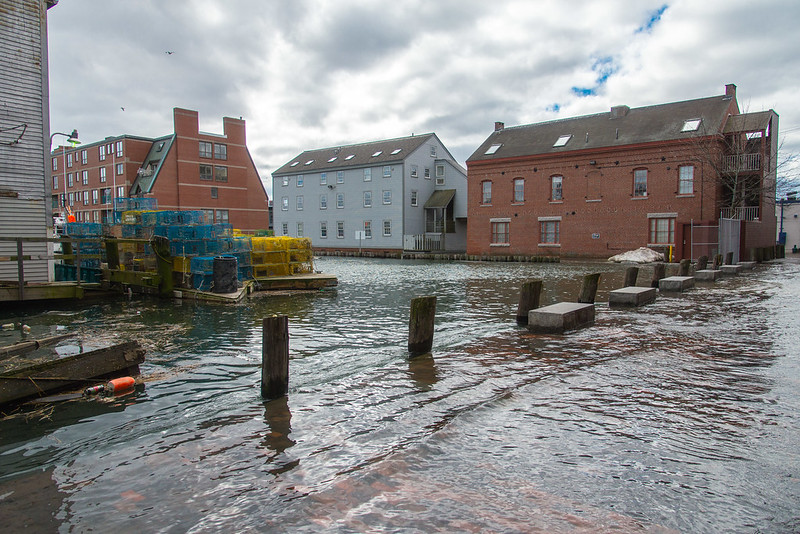Economic Resiliency in the Face of Climate Change

Climate change is expected to have a number of effects in Maine, including coastal flooding, sea level rise, and changing precipitation patterns, among others. Many efforts are already underway to help protect communities from those effects, including zoning changes, new building requirements, armoring or elevating critical infrastructure, and the like. These efforts all fall under the heading “climate resiliency planning,” as they make a community more resilient to the disruptions wrought by changing weather patterns.
Ensuring that a local economy is resilient to climate disruption is nearly as important as physical resiliency. The local economy is a complex web of interactions between customers, workers, businesses, non-profits, and government agencies within the region. Economic resiliency planning can help to make sure that that web does not break – or, at least, is easily rebuilt – after a disaster.
Current approaches to assessing the impact of climate change too often ignore economic changes that are likely to occur. Climate change poses physical threats to current businesses, true, but it also poses economic ones, as supply chains dry up, input prices rise, or competitive advantages shift. Focusing on preserving the economic status quo will do little good if advancing sea level rise and increasingly variable weather patterns result in a markedly changed economic landscape.
The first step in developing an economic resiliency plan for a local economy is to anticipate the likely physical changes that will accompany climate change, by taking a look at what areas of a particular municipality are likely to be impacted by certain events. If you’re located on the coast, or if your town center is situated near a river, as is the case for many Maine towns, flooding from hurricanes or other large storms might be a priority. Or, access may be more of an issue. If your town has one or two main routes in and out of town, how likely are these routes to be block by high water, or by downed trees from wind damage? Many communities have already begun this work, through projections from the National Oceanic and Atmospheric Administration (NOAA) or from the United States Environmental Protection Agency. Through this work, communities can get an idea of what physical assets are at risk from climate-related events.
Next, establish a baseline. What are the largest employers in the municipality? What are the largest sources of tax revenue? What are the key industries, and what is the sectoral composition of the economic base? Where do most of the non-resident employers live, and what routes are they likely to take to work? This will create a starting point to assess the local economy’s vulnerability to climate-related disruption. The results may not always be what you think.
For example, many of Maine’s historically most important industries – agriculture, forestry, fishing, and tourism – depend heavily on the climate. The output from these industries is likely to be directly impacted by any climate disruptions. Agriculture, for example, could be both positively and negatively affected by climate change, as higher temperatures lead to a longer growing season, but also to increased need for irrigation. These are the industries that are deemed “climate-sensitive in supply” by economists.
But there are also industries that are “climate-sensitive in demand” – where consumer demand for goods and services is likely to be affected by changing weather patterns or the physical effects that come with them. Tourism, certainly, is one of these (both positively and negatively). Energy is another.
Less obvious, perhaps, are the effects of underlying price changes and linkages between industries. Let’s give an example. Suppose that an increase in hot, humid weather in the northeast leads to increased demand for air-conditioning. (Most areas in Maine now see fewer than four days a year when the heat index rises above 95 F, but that is predicted to change under most projections.) The increased demand for air-conditioning will likely lead to increased electricity prices. Those higher prices will ripple through the economy, affecting everything from family’s budgets to food prices to costs to businesses.
Finally, labor productivity might be affected by climate change. Why? For those of us who have jobs in air-conditioned buildings, and as such are relatively shielded from the climate, the outdoor temperature might not affect our productivity. But for the proportion of Maine workers who work outside, or do not have access to air conditioning, heat-related stress can be a factor, much as it is for livestock in Maine. Moreover, the effect of warmer temperatures on growing seasons works for pollen-producing plants as well, leading to increased rates of asthma and allergies. The spread of insect-borne diseases, such as Lyme, may affect productivity as well (not to mention impacting the health care sector).
Once the likely changes to the local economy are anticipated, policies can be put in place to help reduce risks. Some of these policies might include encouraging local businesses to engage in disaster preparedness with others rather than in isolation, developing a directory of local businesses that can assist in rebuilding after a disaster, and identifying alternative procurement routes in case of a disruption in transportation infrastructure.
Planning for economic resiliency is less about rebuilding the day after a disaster, and more about planning so that economic disruptions are minimized should a disaster occur. And it doesn’t have to be a stand-alone process. In fact, it shouldn’t be. Planning for economic resiliency should be integrated into planning efforts at all levels, from economic development to housing and infrastructure planning. While a disaster almost by definition is unpredictable, we do have the ability to anticipate the changes that will come with a changing climate. We should take the time now to ensure that those changes don’t derail the local economy.